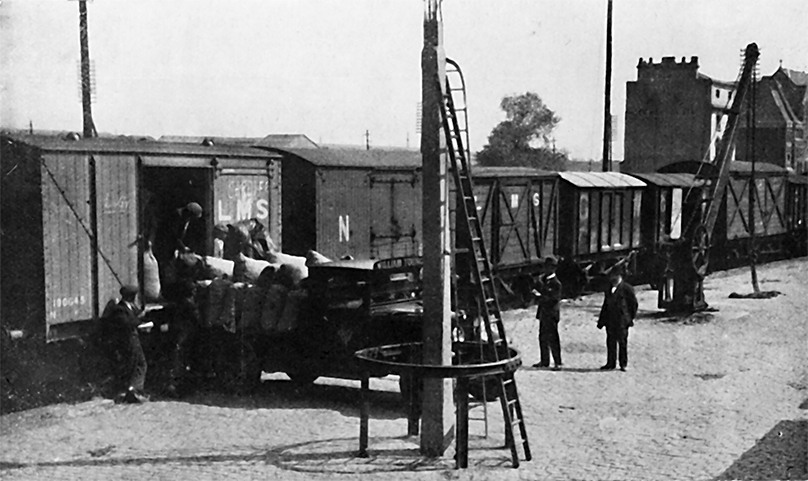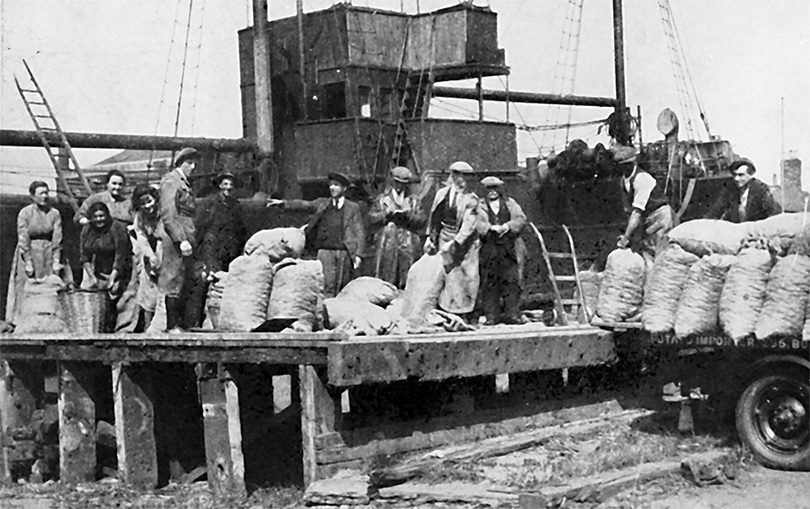

This site uses non-intrusive cookies to enable us to provide a better user experience for our visitors. No personal information is collected or stored from these cookies. The Society's policy is fully explained here. By continuing to use this site you are agreeing to the use of cookies.
[as described in the August 1929 edition of the “in-house” LMS Magazine.]

Loading At Tyndall Street Station, Cardiff. Courtesy S. Wales Echo
NEARLY forty years ago, some enterprising Cardiff merchants saw the possibility of starting a trade in French-grown early potatoes. They visited the French coast districts round Paimpol and Treguier, and bought the early crop, bringing it home in small sailing vessels.
Since then the business has increased to such an extent that at the present time about 20,000 tons of early-grown French potatoes are imported through Cardiff each season.
By far the greater portion of these are consumed locally, or in the immediate neighbourhood, but large quantities are also sent inland during the season, which lasts from the middle of May till the first week in July.
One great market for French potatoes is Birmingham and the Midlands, while "The Potteries" come in for a big share. Other consignments are sent as far as Manchester, Derby, Chesterfield, &c.
The L M S runs special trains, with pipe-fitted stock, in connection with the arrival of the boats, and this enables the potatoes brought into dock on the afternoon of one day, to reach the wholesale markets of Birmingham, Wolverhampton, &c., early the next morning.
There is keen rivalry between the various railway companies to carry this traffic, and efforts are made to obtain signed orders in favour of their respective routes before the season commences.
As previously mentioned, the first craft to bring the potatoes over was the little sailing ship. It rarely carried more than 70 to 80 tons-sometimes only half that weight-and these small boats went up the creeks in France, to where the farmers brought their crops in horse-drawn wagons. Now, in their place, are steamships of 300 to 500 tons capacity, and these are loaded (rom motor vehicles which gather the potatoes from central points. The cargoes are still comparatively small, because only ships of small draught are capable of navigating some of the harbours.
In the early days the potatoes arrived in bulk, that is, loose, and gangs of stalwart women awaited the arrival of the boats at Cardiff and got down into the hold, where they did the bagging. To-day, the potatoes are put into bags by the French farmer before they leave his ground, and this facilitates the discharging of the cargo at destination.
The Cardiff importers send over thousands of new empty bags at the commencement of the season. Some potatoes are packed in hampers or baskets, and an ample supply of these is also sent across early from this side.
The unloading of a potato boat presents a busy spectacle, The bags are brought up from the hold in bundles of twelve, by means of a rope sling worked from a steam winch. Meanwhile a staging of rough boards is run from the railway wagon, or trolley, to the ship's side, against which it is fastened, and the unloaders dart backwards and forwards along the planks, each carrying a hundredweight bag on his shoulders. The procedure reminds one of an anthill, with the ants scurrying away with their eggs.
The business of potato importing is a very speculative one, prices rising, or falling, according to whether there is a scarcity or a glut of the market. At the beginning of the season the importer sends out his agent, placing anything up to £20,000 to his credit to pay (or his purchases from day to day. However keen he may be, it may' easily happen that after he has bought, the market drops, and his employer has to sell the potatoes at, say, £3 per ton less than the price paid for them in France. On a lot of 300 tons, this means that something in the neighbourhood of £1,000 has been lost. The merchant hopes that on the next occasion the reverse will happen, and that the price, by rising, will enable him to recoup his losses. Another point he has to watch at the beginning of the season is whether there are any other stocks of potatoes on the market still undisposed of.
The Spanish crop is earlier than the French, and unless this has been absorbed before the French crop comes in, the price starts low from the outset.
The earliest imported potatoes are from Algeria, then follow those from the Canary Islands, to be succeeded by the Spanish, and afterwards comes the crop about which we are writing.
The French crop fills the requirements of the English market during the six or seven weeks immediately before the home crop comes to maturity.
In the days of the sailing ship, the voyage from France to Cardiff was not unattended with risk.as rough weather was often experienced round the Lands End and up the stormy Bristol Channel. Steam has now eliminated a good deal of the former danger, but a couple of years ago a ship, with 400 tons of potatoes on board, went to the bottom off the coast of Cornwall, while the master and crew took to the boats; and another Cardiff-bound steamer had to run into Falmouth in a sinking condition, having encountered very rough weather.
The principal points from which the French potatoes are sent to Cardiff are: Treguier, Roscoff, Paimpol, Loctudy, Pont I' Abbe, and St. Malo.

Unloading Potatoes From Steamer. Courtesy S. Wales Echo
Site contents Copyright © LMS Society, 2024

April 19th, 2024
Site contents Copyright © LMS Society, 2024